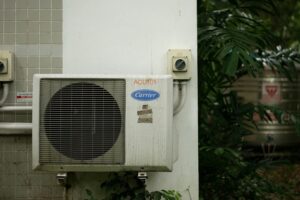When hot days in spring, summer, and early fall come rolling in, it’s nice to have a cooling system in place in your home to beat the heat. Some people have portable window air conditioners to cool the house, while others have central air conditioners. They both work well; you need to determine your usage pattern to decide what makes the most sense for you.
Central air conditioners are favored for homes that require cooling throughout all their spaces; however, it is costlier in most cases. Window units effectively cool a room, provided they are sized correctly for the room. The energy to use a window unit versus a sizeable central air compressor varies dramatically, so if you only need one room cooled versus the whole house, it makes sense to use more localized units to save on energy usage and costs. However, if you need to buy and maintain more than five window units, they will be more expensive than buying and maintaining a central air conditioner.
What Is Central Air?
To cool your home, you have several options: a centralized system of ducts throughout your home (central air), a ductless mini-split or floor mount, window air conditioners, or portable air conditioners. Each method works essentially the same; the air conditioner removes heat and humidity from the indoor air and returns cooled air to the indoor space, transferring the unwanted heat and humidity outside.
The most significant difference between them is how air gets circulated throughout your home: do you have a system of ducts that reaches the entire home? Or is the unit localized to a room? Central air works in each room that has ducts connected to it. Meanwhile, all the other systems are localized—cooling the air of the space where the unit is mounted or positioned.
A central air system cools all the rooms connected to ducts at once, getting the home cooler quickly. However, it is the most expensive method of home cooling.
How Does Central Air Work?
Central air conditioners incorporate two different coils to cool your home. The cooling compressor is set outside the home, separate from the fan unit used to blow the cool air throughout the home on the central air unit. The central air unit can cool the entire home evenly by using the existing heating and cooling ducts throughout the home.
The coil outside of your home is called the condensing coil. It consists of a compressor, condensing coil condenser fan, and a grill to protect persons from coming into contact with the fan blade, a case built around all of the components, controls, and two refrigerant lines that run into the home to the evaporator coil.
The refrigerant inside the compressor is pumped through the evaporator coil inside, which cools the air as the furnace fan blows air through the coil. The coil absorbs the heat from the air. Then the refrigerant flows back outside to the condenser coil, and this is where the heat that was absorbed is released. The refrigerant returns to a liquid form as it is cooled, and the cycle continues until the home reaches the desired temperature.
Maintaining Your Central Air Conditioner
To keep the central air conditioner working properly, regular maintenance is required. Maintenance includes replacing filters regularly, oiling the fan motor, and keeping the parts clean and debris-free. To oil the motor, turn off the power to the system and remove the fan cage, which holds the fan motor in place. Turn the cage assembly upside down to access the oil ports on the motor.
These ports will be located on the top of the motor, just below the motor’s fan blade. Remove the oil plugs that protect the motor from debris. Each port should be oiled with three drops of all-purpose, three-in-one oil. Spin the fan blade slowly by hand to disperse the oil within the fan. Now, replace the oil plugs and wipe any excess oil that might have spilled. You should repeat this process each season to ensure proper lubrication and longevity for your fan motor.
Cleaning the Cooling Fans
At least once a year, especially before the season starts, turn off the unit and use a garden hose to clean the cooling fins to remove any dirt, grass clippings, leaves, and other debris from the unit. Hot, dry summer days and windy, sand-blowing winds helped cake the condenser’s fins and lessen the cooling capacity.
You need to change the filter on your furnace’s return air duct often to get good airflow. A dirty filter will cause low airflow and can cause the unit to freeze up, restricting airflow even more.
One last thing to consider is the furnace’s fan responsible for blowing the cool air out into your home. It needs a fair amount of maintenance. The fan needs to be oiled from time to time, just like the outdoor unit.
Text taken from: https://www.thespruce.com






